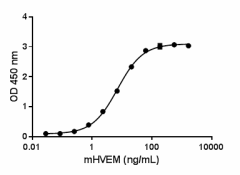- Regulatory Status
- RUO
- Other Names
- CD272, B- and T-lymphocyte attenuator, B- and T-lymphocyte-associated protein

-

Immobilized recombinant human BTLA at 1.0 µg/mL binds recombinant mouse HVEM in a dose dependent manner with EC50 of 7 - 21 ng/mL. -

Stability testing for Human BTLA. Human BTLA was aliquoted in PBS, pH 7.2 at 0.2 mg/mL. One aliquot was freeze thawed four times (4x freeze/thaws), and compared to a control kept at 4°C (control). The samples were tested for their ability to bind mouse HVEM in a functional ELISA.
| Cat # | Size | Price | Quantity Check Availability | ||
|---|---|---|---|---|---|
| 775702 | 10 µg | $65.00 | |||
| 775704 | 25 µg | $94.00 | |||
| 775706 | 100 µg | $335.00 | |||
Select size of product is eligible for a 40% discount! Promotion valid until December 31, 2024. Exclusions apply. To view full promotion terms and conditions or to contact your local BioLegend representative to receive a quote, visit our webpage.
BTLA (B and T lymphocyte attenuator, CD272) is a type I transmembrane glycoprotein with four extracellular cysteine-rich domains. It is an inhibitory molecule structurally and functionally similar to cytotoxic T lymphocyte antigen-4 (CTLA-4) and programmed death-1 (PD-1). These molecules belong to the immunoglobulin superfamily that binds B7 family members. Different from CTLA-4 and PD-1 binding with the B7 family members, BTLA interacts with herpes virus entry mediator (HVEM) which belongs to TNFR family. BTLA/HVEM interaction was the first demonstration of crosstalk between these two family members. BTLA/HVEM interaction negatively modulates T cell activation. HVEM induces BTLA tyrosine phosphorylation and inhibits T-cell proliferation. There is accumulating evidence suggesting that BTLA/HVEM signaling also plays an important role in autoimmunity and infection at mucosal surfaces. The BTLA/HVEM interaction does not prevent the simultaneous binding of other HVEM ligands such as LIGHT or Lymphotoxin-alpha. BTLA is expressed on T cells, B cells, macrophages, dendritic cells, and natural killer cells. Constitutive expression level of BTLA on resting T cells are very low, but increase after the activation of T cells. BTLA is highly expressed on resting B cells.
Product Details
- Source
- Human BTLA, amino acids Lys31-Trp153 (Accession # Q7Z6A9) with a C-terminal human IgG1 (Pro100-Lys330) Fc tag expressed in CHO cells.
- Molecular Mass
- The 362 amino acid recombinant protein has a predicted molecular mass of approximately 41 kD. The DTT-reduced protein migrates at approximately 55 kDa and and non-reduced protein migrates at approximately 110 kDa by SDS-PAGE. The predicted N-terminal amino acid is Lys.
- Formulation
- 0.22 µm filtered protein solution is in PBS, pH 7.2
- Endotoxin Level
- Less than 0.1 EU per µg protein as determined by the LAL method.
- Concentration
- 10 and 25 µg sizes are bottled at 200 µg/mL. 100 µg size and larger sizes are lot-specific and bottled at the concentration indicated on the vial. To obtain lot-specific concentration and expiration, please enter the lot number in our Certificate of Analysis online tool.
- Storage & Handling
- Unopened vial can be stored between 2°C and 8°C for up to 2 weeks, at -20°C for up to six months, or at -70°C or colder until the expiration date. For maximum results, quick spin vial prior to opening. The protein can be aliquoted and stored at -20°C or colder. Stock solutions can also be prepared at 50 - 100 µg/mL in appropriate sterile buffer, carrier protein such as 0.2 - 1% BSA or HSA can be added when preparing the stock solution. Aliquots can be stored between 2°C and 8°C for up to one week and stored at -20°C or colder for up to 3 months. Avoid repeated freeze/thaw cycles.
- Activity
- When human BTLA is immobilized at 1.0 µg/mL (100 µL/well), recombinant mouse HVEM binds with EC50 of 7 - 21 ng/mL in a functional ELISA.
- Application
-
Bioassay
- Application Notes
-
BioLegend carrier-free recombinant proteins provided in liquid format are shipped on blue-ice. Our comparison testing data indicates that when handled and stored as recommended, the liquid format has equal or better stability and shelf-life compared to commercially available lyophilized proteins after reconstitution. Our liquid proteins are verified in-house to maintain activity after shipping on blue ice and are backed by our 100% satisfaction guarantee. If you have any concerns, contact us at tech@biolegend.com.
Antigen Details
- Distribution
-
T cells, B cells, macrophages, dendritic cells, and natural killer cells.
- Function
- Lymphocyte inhibitory receptor which inhibits lymphocytes during immune response
- Interaction
- Lymphocytes
- Ligand/Receptor
- HVEM
- Bioactivity
- Measured by its ability to bind mouse HVEM
- Cell Targets
- Lymphocytes
- Cell Type
- B cells, Dendritic cells, Tregs
- Biology Area
- Cancer Biomarkers, Cell Biology, Immunology, Inhibitory Molecules
- Molecular Family
- Immune Checkpoint Receptors, Soluble Receptors
- Antigen References
-
- Watanabe N, et al. 2003. Nat. Immunol. 4: 670-9
- Gavrieli M, et al. 2003. Biochem. Biophys. Res. Commun. 312: 1236-43
- Gonzalez LC, et al. 2005. Proc. Natl. Acad. Sci. U S A 102: 1116-21
- Sedy JR, et al. 2005. Nat. Immunol. 6: 90-98
- Murphy KM, et al. Nat. Rev. Immunol. 6: 671-81
- Gene ID
- 151888 View all products for this Gene ID
- UniProt
- View information about BTLA on UniProt.org
